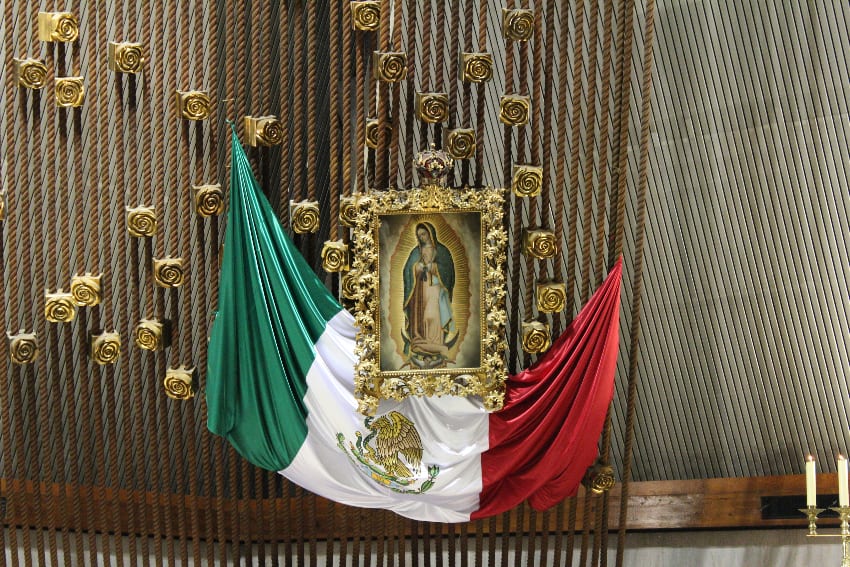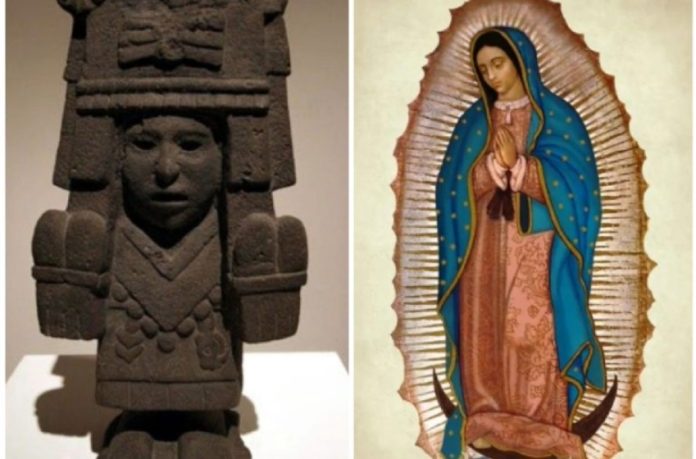Every year on Dec. 12, millions of faithful from all over the country travel to the Basilica of Our Lady of Guadalupe north of Mexico City to celebrate the visions the Indigenous peasant Juan Diego had of the Virgin Mary.
According to the story, the apparitions occurred on the Hill of Tepeyac (just behind the current-day basilica) between Dec. 9 and 12, 1531 – ten years after the fall of Tenochtitlan (capital of the Mexica empire) to the Spanish domain. Since then, Tepeyac has been a revered Catholic site of worship in Mexico.
However, that same hill was sacred for the Mexica even before the Spanish arrived, as it was the place of worship for another Indigenous deity: Tonantzin.
“It is no coincidence that she [the Virgin Mary] appeared to Juan Diego, who despite his name, was still an Indigenous person,” said Santiago del Bosque Arias, an Art Historian at the National Autonomous University of Mexico (UNAM).
“The Nahuatl people held great reverence for Tonantzin, and she was worshiped precisely on the Tepeyac,” del Bosque Arias continued.
What’s the story of the apparitions of our Lady of Guadalupe according to the Catholic Church?

As the story goes, the Virgin Mary appeared to Juan Diego on the Hill of Tepeyac five times, revealing herself as the mother of God and the “collective mother.” In his visions, she asked him (in Nahuatl) to go tell Bishop Zumárraga of New Spain to build a chapel in her honor on the Hill of Tepeyac.
Juan Diego went to the bishop two times, but he didn’t believe him and asked for proof. On the next visit, the Virgin Mary miraculously imprinted her likeness on Juan Diego’s cloak (tilma or ayate) as dozens of roses he had picked up on the Tepeyac – at the request of the Virgin Mary – fell out of his cape.
Amazed, the bishop gave his blessing and ordered a chapel constructed in her honor in the same place where the apparitions occurred. It was a modest chapel at first, renovated throughout centuries until a basilica – known today as the “Old Basilica” – was built in 1709.
Juan Diego’s cloak is now exhibited in the new basilica, where it is safeguarded behind glass.
What’s the story of Tonantzin according to Mexica tradition?
According to Fray Bernardino de Sahagún’s “General History of the Things of New Spain,” written between 1540 and 1585, there was a temple dedicated to the deity Tonantzin on the Tepeyac (originally called “Tepeaca”) before the apparitions of the Virgin Mary.
“There in Tepeaca, where the church that you ordered to be built is located, they made many sacrifices in honor of a goddess named Tonantzin […] which means ‘our mother.’”
“They said that this goddess […] appeared many times […] as a composed lady with attires such as those used in the palace. They say that she carried a cradle on her back, like someone carrying her child in it,” Sahagún described.
In a contemporary publication called “El pueblo del sol,” Alfonso Caso adds that Tonantzin was a name used by the Mexica to refer to the mother of the gods and hence “our mother.” She was also called Toci, “our grandmother.”
These records show that Tonantzin was a name given to certain goddesses who are considered mothers of the Nahuas (the Mexica and all of the communities that spoke Nahuatl), such as Cihuacóatl (‘snake woman’) or Coatlicue (‘serpent skirt’).
Sahagún also wrote that Tonantzin’s temple on the Tepeyac received many pilgrims on the feast day of Tonantzin. Men and women would go “from very distant lands, more than twenty leagues, from all regions of Mexico, bringing many offerings.”
How did the two stories merge according to historians?
“We must see the two figures as a union, or rather, the place where the Indigenous and peninsular (Spanish) parts converge,” del Bosque said, as the Virgin of Guadalupe was a “figure that facilitated the conversion of Indigenous people to Catholicism,” he explained.
After the conquest of Tenochtitlan, the Spanish colonizers destroyed symbols of Indigenous religions and replaced them with traditional Catholic imagery, building churches on top of temples.
Such was the case of Our Lady of Guadalupe’s temple, which replaced that of Tonantzin.
According to “Las informaciones de 1556” (The Informations of 1556), which contains an account of the cult to Our Lady of Guadalupe by the religious orders of New Spain, it was Bishop Alonso de Montúfar who started telling stories about the supernatural powers of the Virgin Mary’s image placed on the site of the apparitions.
That same account reveals that Fray Francisco de Bustamante – who was against the new cult surrounding the mystical image as it contradicted the Spaniards’ rule prohibiting the adoration of religious images – identified a native artist as the maker of the painting: a man known as “Marcos, Indio Pintor” (Marcos, Indian painter).
Many historians recognize Marcos as the author of the image on the basilica.
“From this, you can reflect on many things,” del Bosque said. “Why was the artist an artist of Indigenous origin? Who was the image addressed to? Why wasn’t the image assigned to one of the painters who came from Spain?”

While the cult surrounding the image of the Virgin of Guadalupe grew in popularity amongst Spaniards in Mexico and their descendants, in the Tepeyac, natives still honored Tonantzin instead of the Virgin of Guadalupe.
According to Sahagún, the locals’ devotion was “suspicious,” since they only made pilgrimages to the Tepeyac and not to the other churches in the region built in honor of Our Lady of Guadalupe.
However, as the Spaniards continued to celebrate mass in honor of the Virgin Mary, popular devotion eventually shifted to Our Lady of Guadalupe.
In 1666, the Catholic Church officially began an investigation into the apparitions on the Hill of Tepeyac and approved the Virgin of Guadalupe as the patron of New Spain in 1754.
Since then, the Feast of our Lady of Guadalupe has become a defining aspect of Mexican identity.
By Gabriela Solís, Mexico News Daily writer
